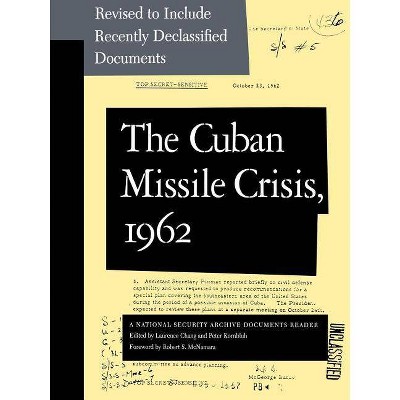The Cuban Missile Crisis - by Jonathan Colman (Paperback)

Similar Products
Products of same category from the store
AllProduct info
<p/><br></br><p><b> About the Book </b></p></br></br><p>Drawing on an extensive body of research, including primary sources released only in the last few years, this work places the crisis in a broader international and chronological context than previously possible. </p><p/><br></br><p><b> Book Synopsis </b></p></br></br><p>October 1962, The Cuban Missile Crisis: the confrontation that brought the world closer to nuclear catastrophe than ever before or since. Both John F. Kennedy and Nikita Khrushchev were determined to avoid nuclear war, but events could easily have spiraled out of control with cataclysmic results. Drawing on an extensive body of research, including primary sources released only in the last few years, this work places the crisis in a broader international and chronological context than previously possible. Discover how America was responsible for causing the conflict and Cuba's role as an important actor rather than a superpower pawn.</p><p/><br></br><p><b> From the Back Cover </b></p></br></br>'Drawing on both historical documents and state-of-the-art research, this is a valuable introduction to a seminal and timeless event in conflict resolution and political decision-making.' J.J. Widen, Associate Professor in War Studies, Swedish Defence University The most dangerous confrontation in history seen from a global perspective The Cuban Missile Crisis was a six-day clash in October 1962 between the United States and the Soviet Union over the presence of Soviet nuclear missiles in Cuba. Both John F. Kennedy and Nikita Khrushchev were determined to avoid nuclear war, but events could easily have spiralled out of control with cataclysmic results. This book provides a lucid and up-to-date introduction to the Crisis, including American responsibility for causing it, and Cuba's role as an important actor rather than a superpower pawn. Drawing on an extensive body of research, including material released only on the fiftieth anniversary of the crisis, this book places the event in a broader international and chronological context than ever before. It features a number of primary source documents, some of which have rarely - if ever - been reproduced, and includes a discussion of the legacies of the Crisis. Key Features and Benefits - A concise and engaging introduction to one of the most dramatic and dangerous episodes in history - Up-to-date coverage, supplementing analysis with recently released documents and both Soviet and Cuban primary source material - Features a rare exploration of the global dimensions of the Crisis, including the contributions from numerous countries in Latin America and Europe - Provides an account of the aftermath including some of the troubling legacies in theatres such as Vietnam Jonathan Colman teaches international and US history at the University of Central Lancashire. He is the author of The Foreign Policy of Lyndon B. Johnson: The United States and the World, 1963-1969, Edinburgh University Press (2010), among many other works. Cover image: The Rape of the Sabine Women, Pablo Picasso, 1962 (c) Succession Picasso/DACS, London 2016, photo: akg-images Cover design: [EUP logo] www.euppublishing.com ISBN (cover): 978-0-7486-9630-7 ISBN (PPC): 978-0-7486-9628-4 Barcode<p/><br></br><p><b> Review Quotes </b></p></br></br><br><p>Despite the Cuban Missile Crisis being one of the most studied episodes of Cold War confrontation, Colman's book is a welcome addition. It provides an excellent overview and will be useful for those unfamiliar with the crisis or looking for an accessible introduction. It will be particularly expedient for undergraduate students as, in addition to the discerning analysis, the appendices provide a chronology of events, short biographies of the major players and a selection of 16 key documents, which elucidate aspects of the main arguments. It will also be welcomed by experts in American foreign policy and the international history of the Cold War more broadly, through an engagement with the most recent research and scholarship on the crisis. Colman's <em>Cuban Missile Crisis</em> is an accessible and eminently readable book for anyone with an interest in the global perspective of one of the most important international events during the Cold War era. </p>--Conor Tobin, University College Dublin "History: The Journal of the Historical Association"<br><p/><br></br><p><b> About the Author </b></p></br></br><p>Jonathan Colman teaches international and US history at the University of Central Lancashire, Preston, England. He is the author of A 'Special Relationship'? Harold Wilson, Lyndon B. Johnson and Anglo-American Relations 'at the Summit', 1964-68 (2004), and The Foreign Policy of Lyndon B. Johnson: The United States and the World, 1963-69 (2010). He has also published numerous articles in leading peer-reviewed journals.<p>
Price History
Price Archive shows prices from various stores, lets you see history and find the cheapest. There is no actual sale on the website. For all support, inquiry and suggestion messagescommunication@pricearchive.us




















